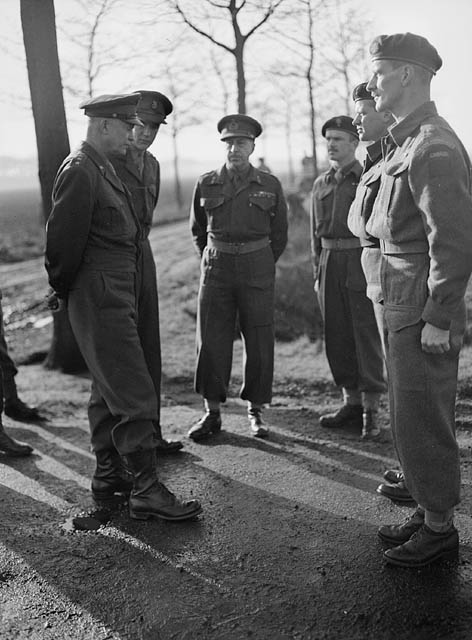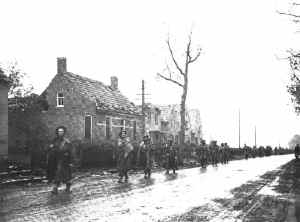The Battle of the Scheldt

General Dwight Eisenhower visits units of the 4th Canadian Armoured Division.
This caught the German defenders off balance, as they were lined up facing the Leopold Canal. The strategy paid off. Now the Canadians had to clear out the Breskens Pocket. There was mud, mud and more mud. It was cold weather, rain and wind. While the 3rd Division was fighting in the Breskens Pocket, the 2nd Division and the 4th Armored Division moved from Antwerp towards the Beveland peninsula. The second part of the operation was code named Vitality. The Germans paratroopers offered solid resistance, and the Canadians gained little ground. 5th Brigade attacked and also faced tough German resistance. The Canadian Army was decimated due to the losses it had incurred since June 1944, and was in need of replacements.
{default}The Reserve was made in such a way that it was estimated that the infantry would suffer 50% of the casualties, and the other 50% would be to the rest. But it turned out that the casualty rate taken by the infantry was more like 75 to 80%. The French speaking regiments were particularly hard pressed, as the base of recruits was much smaller. The army was forced to scour the front for troops, and this lead them to enlist other trades, like engineers. They were trained for about 2 to 3 weeks as an infantryman, and then sent as replacements. Sadly, a lot of them did not last 24 hours.
The 2nd Division’s manpower problem would only get worse, as they were to attack and take a small town called Woensdrecht. This town was vital for communications. On the 13th of October 1944, the Blackwatch Royal Highland Regiment of Canada (from Montreal), was about to meet it’s Waterloo. The Brigade Commander gave the order for the Blackwatch to attack Woensdrecht across open country, with no cover of any sort. The terrain was flat and low and had not been flooded. The Germans had the high ground. They had their guns and machineguns zeroed in on the Blackwatch. This was an impossible attack, and the Blackwatch had to withdraw.
The Regiment paid a horrendous price: 66 killed, 36 missing and 91 wounded. This day would be known as Black Friday for the Canadian infantry. On the 16th of October 1944, it was the turn of the Royal Hamilton Light infantry, under Lt Col Denis Whitaker, to attempt to capture Woensdrecht. The Canadians were supported by a squadron of tanks and artillery, and they attacked at night around 3 or 4 in the morning. The attack succeeded, and the Hamilton was able to take the town from the Germans.
However, the Germans had reserves consisting of a Regiment of Paratroopers under the command of Lt Colonel von der Heydte who were excellent troops. Early the next morning, they commenced counter attacking the Hamiltons. German troops managed to overrun one of the defending companies. One officer, Major Joseph Pigott, saw that there was only one way to stop them and that was calling artillery down on his own HQ. Lt Colonel Whitaker ordered the artillery barrage, and 350 guns opened up and fired 10 rounds each right on Pigott’s position. Fortunately for the Canadians, they were well dug in and they suffered only one minor injury casualty. But the Germans who were counter attacking with tanks and self-propelled guns were completely destroyed.
It would take five more days before the battle for Woensdrecht was over. The battlefield was a display of carnage. The Canadians had suffered heavily, but there was no time to dwell on their losses, as they had to press on to Beveland. The 52nd British Division (Lowland) made an amphibious landing on the south of the Beveland peninsula, and soon linked up with the Canadians, who were pressing their attack. The combined force made steady progress. The weather and the terrain continued to make the soldiers lives miserable, however.

Calgary Highlanders marching in south Beveland, late October 1944.


My father was Merchant Navy (Steward) and was on the second merchant vessel (Empire Asquith) behind Fort Cataraqui. The convoy was under attack from V1 rockets, U-Boats and mines. It should be pointed out that the people of Antwerp – the Flemish, were also grateful to the relief of Antwerp by the Canadian forces as well as British commandos (never mentioned, the Royal Navy and last but not least the forgotten service ‘The Merchant Navy’
My old ship HMS Aristocrat a paddle ship having been in Normandy DDay, was involved with the battle on the Scheldt and was one of the first ships into Antwerp.
I’m always disappointed that she never gets a mention in any account of history.
I remember it well. If the book called a ‘Paddler goes to war’ is read you will find it there.
Netflix has just released a new movie based around the battle. https://www.nextflicks.tv/review/the-forgotten-battle/